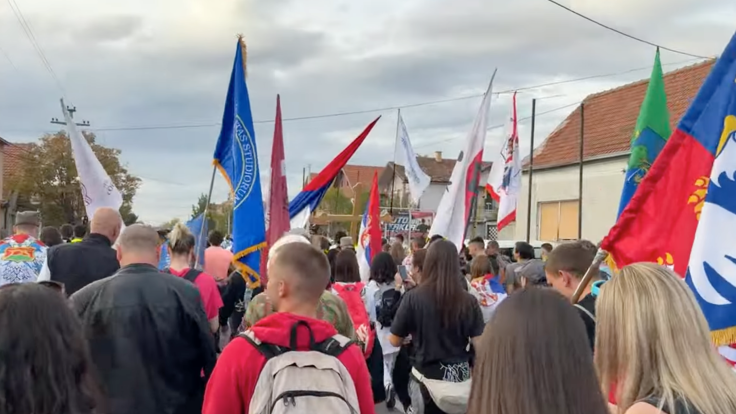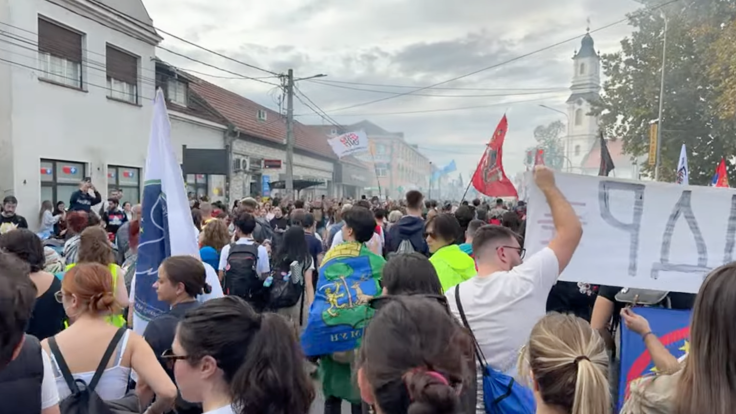Grief and Fury Linger as Serbia Marks One Year Since Novi Sad Station Tragedy
Nation remembers 16 victims as protests reignite over corruption and leadership

Thousands of Serbians filled the streets of Novi Sad on Saturday to mark one year since the collapse of the city's newly renovated railway station roof, a disaster that killed 16 people and ignited one of the country's largest protest movements in decades.
At 11:52am, the exact moment the roof gave way on that autumn morning in 2024, crowds fell silent for 16 minutes, one for each victim, as families laid flowers and candles at the site where twisted metal and shattered glass once lay.
The ceremony, solemn yet defiant, came as anger still simmers over what many Serbians see as a symbol of corruption, negligence and political favouritism under President Aleksandar Vučić's government.
Calls for Justice and Reform
Despite promises of reconstruction, the railway station remains unrepaired, its skeletal frame standing as a monument to broken trust.
Mourners held placards reading 'Corruption Kills' and 'Justice for the 16', while students led the procession, transforming grief into a rallying cry for accountability.
'Every other protest movement was organised by political opposition parties, and people in Serbia don't trust them,' said Aleksa, a 23-year-old management student from Novi Sad. 'We are the most trusted group in the country. That's why, even though we've made mistakes, people believe in us.'
Student groups, unaffiliated with political parties, have organised months of demonstrations demanding early elections and an independent inquiry into what went wrong. They have even proposed forming a technocratic government of experts to rebuild institutions free from political interference.

Government Under Fire
The government has faced mounting criticism both at home and abroad. In September, 13 officials were charged in connection with the collapse, including former Construction and Transport Minister Goran Vesić.
The European Parliament also passed a resolution demanding a full and transparent investigation, citing the need to expose corruption and lax safety standards that may have contributed to the tragedy.
The European Union's commissioner for enlargement, Marta Kos, praised the movement for 'standing up for accountability, free expression and inclusive democracy', calling the disaster a turning point for Serbia's future.
President Vučić initially dismissed the protests as the work of 'foreign-backed terrorists' and accused organisers of plotting a 'colour revolution'.
But on the eve of the anniversary, he unexpectedly softened his tone. In a televised address, Vučić apologised for his earlier remarks, saying, 'I have said some things that I am now sorry for saying.'
His apology, however, failed to ease public anger. Student leaders dismissed it as 'too little, too late', insisting the government still had 'blood on its hands'.
From Tragedy to Movement
The Novi Sad station collapse was once hailed as a symbol of progress. Opened in 2022, the sleek terminal formed part of a high-speed rail project linking Belgrade and Budapest, inaugurated by Vučić and Hungarian Prime Minister Viktor Orbán.
But when the roof caved in just two years later, it transformed pride into fury. The tragedy exposed deep cracks in Serbia's governance, not only in infrastructure but in public trust.
What began as mourning has evolved into a youth-led protest movement that analysts say has achieved what the fragmented political opposition could not: reconnecting citizens across generations and backgrounds.
'They have cut across families,' said MP Biljana Djordjević. 'We always wanted young people to be more vocal, and now they are.'
One year ago, the Novi Sad train station collapse took 16 lives.
— Marta Kos (@MartaKosEU) November 1, 2025
We remember them today.
This tragedy is changing Serbia.
It moved masses to stand for accountability, free expression and inclusive democracy.
They are the same values to lead Serbia into the EU.
A Nation in Mourning and Transition
The Serbian government has declared 1 November a national day of mourning, with flags lowered to half-mast. Yet the atmosphere in Novi Sad was one not just of sorrow but of determination.
Tens of thousands marched through the city's main square holding white lilies and flickering candles. Many wore black armbands reading 'Never Again', while church bells tolled across the city skyline.
For families of the victims, justice has yet to be delivered. For the nation's youth, the fight is far from over.
The grief remains, but so too does the fury, and it is reshaping Serbia's political future one year after tragedy struck.
© Copyright IBTimes 2025. All rights reserved.





















